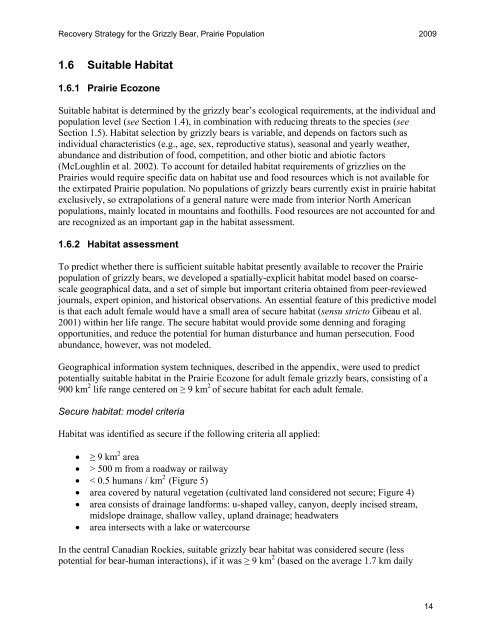Grizzly Bear (Ursus arctos), Prairie Population - Publications du ...
Grizzly Bear (Ursus arctos), Prairie Population - Publications du ...
Grizzly Bear (Ursus arctos), Prairie Population - Publications du ...
You also want an ePaper? Increase the reach of your titles
YUMPU automatically turns print PDFs into web optimized ePapers that Google loves.
Recovery Strategy for the <strong>Grizzly</strong> <strong>Bear</strong>, <strong>Prairie</strong> <strong>Population</strong> 2009<br />
1.6 Suitable Habitat<br />
1.6.1 <strong>Prairie</strong> Ecozone<br />
Suitable habitat is determined by the grizzly bear’s ecological requirements, at the indivi<strong>du</strong>al and<br />
population level (see Section 1.4), in combination with re<strong>du</strong>cing threats to the species (see<br />
Section 1.5). Habitat selection by grizzly bears is variable, and depends on factors such as<br />
indivi<strong>du</strong>al characteristics (e.g., age, sex, repro<strong>du</strong>ctive status), seasonal and yearly weather,<br />
abundance and distribution of food, competition, and other biotic and abiotic factors<br />
(McLoughlin et al. 2002). To account for detailed habitat requirements of grizzlies on the<br />
<strong>Prairie</strong>s would require specific data on habitat use and food resources which is not available for<br />
the extirpated <strong>Prairie</strong> population. No populations of grizzly bears currently exist in prairie habitat<br />
exclusively, so extrapolations of a general nature were made from interior North American<br />
populations, mainly located in mountains and foothills. Food resources are not accounted for and<br />
are recognized as an important gap in the habitat assessment.<br />
1.6.2 Habitat assessment<br />
To predict whether there is sufficient suitable habitat presently available to recover the <strong>Prairie</strong><br />
population of grizzly bears, we developed a spatially-explicit habitat model based on coarsescale<br />
geographical data, and a set of simple but important criteria obtained from peer-reviewed<br />
journals, expert opinion, and historical observations. An essential feature of this predictive model<br />
is that each a<strong>du</strong>lt female would have a small area of secure habitat (sensu stricto Gibeau et al.<br />
2001) within her life range. The secure habitat would provide some denning and foraging<br />
opportunities, and re<strong>du</strong>ce the potential for human disturbance and human persecution. Food<br />
abundance, however, was not modeled.<br />
Geographical information system techniques, described in the appendix, were used to predict<br />
potentially suitable habitat in the <strong>Prairie</strong> Ecozone for a<strong>du</strong>lt female grizzly bears, consisting of a<br />
900 km 2 life range centered on ≥ 9 km 2 of secure habitat for each a<strong>du</strong>lt female.<br />
Secure habitat: model criteria<br />
Habitat was identified as secure if the following criteria all applied:<br />
� ≥ 9 km 2 area<br />
� > 500 m from a roadway or railway<br />
� < 0.5 humans / km 2 (Figure 5)<br />
� area covered by natural vegetation (cultivated land considered not secure; Figure 4)<br />
� area consists of drainage landforms: u-shaped valley, canyon, deeply incised stream,<br />
midslope drainage, shallow valley, upland drainage; headwaters<br />
� area intersects with a lake or watercourse<br />
In the central Canadian Rockies, suitable grizzly bear habitat was considered secure (less<br />
potential for bear-human interactions), if it was ≥ 9 km 2 (based on the average 1.7 km daily<br />
14

















